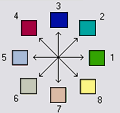D8FlowDir (Input_Pit_Filled_Elevation_Grid,
Input_Number_of_Processes, Output_D8_Flow_Direction_Grid, Output_D8_Slope_Grid)
| Parameter | Explanation | Data Type |
|---|---|---|
| Input_Pit_Filled_Elevation_Grid | Dialog
Reference A grid of elevation values. This is usually the output of the "Pit Remove" tool, in which case it is elevations with pits removed. Pits are low elevation areas in digital elevation models (DEMs) that are completely surrounded by higher terrain. They are generally taken to be artifacts of the digitation process that interfere with the processing of flow across DEMs. So they are removed by raising their elevation to the point where they just drain off the domain. This step is not essential if you have reason to believe that the pits in your DEM are real. This step can be circumvented by copying the raw DEM source data onto the file with suffix "fel" to simulate the output of "Pit Remove" without actually removing the pits. Also, if a few pits actually exist and so should not be removed, while at the same time others are believed to be artifacts that need to be removed, the actual pits should have "no data" elevation values inserted at their lowest point. "No data" values serve to define edges of the domain in the flow field, and elevations are only raised to where flow is off an edge, so an internal "no data" value will stop a pit from being removed, if necessary. There is no python reference for this parameter. |
Raster Layer |
| Input_Number_of_Processes | Dialog
Reference The number of stripes that the domain will be divided into and the number of MPI parallel processes that will be spawned to evaluate each of the stripes. There is no python reference for this parameter. |
Long |
| Output_D8_Flow_Direction_Grid | Dialog
Reference A grid of D8 flow directions which are defined, for each cell, as the direction of the one of its eight adjacent or diagonal neighbors with the steepest downward slope. Flow Direction Coding: 1 -East, 2 - Northeast, 3 - North, 4 - Northwest, 5 - West, 6 - Southwest, 7 - South, 8 - Southeast.
There is no python reference for this parameter. |
Raster Dataset |
| Output_D8_Slope_Grid | Dialog
Reference A grid giving slope in the D8 flow direction. This is measured as drop/distance. There is no python reference for this parameter. |
Raster Dataset |
